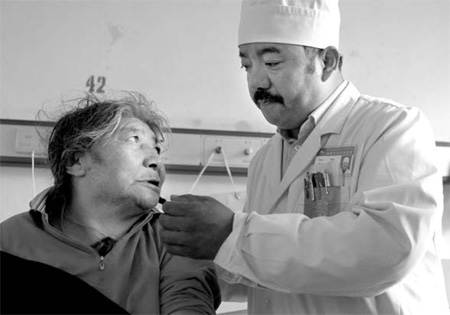
Nyima, a 56-year-old Tibetan doctor, diagnoses a patient at the Tibet Medical Hospital in Lhasa on May 23. Feng Yongbin / China Daily
As a boy, Nyima was shocked the first time he saw his father diagnose an illness by reading someone's pulse.
"He was aware of patients' conditions, even lifestyles, by putting his fingers on their wrists," Nyima said. "It seemed a miracle for me."
Nyima, then 13, begged his father to let him feel the pulse, but he didn't know how the pulsations could carry so much information.
"My father laughed and taught me how to recognize subtle differences between different pulses," said Nyima, now a 56-year-old Tibetan doctor at the Tibet Medical Hospital in Lhasa. "He said I can only master this skill after decades of experience and hard training, but Tibetan medicine had already become fascinating to me."
Compared with modern hospitals, the Tibet Medical Hospital is old and dim. The smell of herbal medicine pervades the building and local patients wearing traditional Tibetan wool cloaks wait on wooden benches outside doctors' offices.
When Nyima arrives at his office - a small consulting room at the end of a corridor - his patients rise to greet him. A big smile flashes on his tanned face, and he touches his thick mustache with a thumb and jokes to his patients.
"Wait for me a little longer, I have to change into a white uniform to be a doctor," he says. Everybody laughs. Nyima is one of the most popular doctors in the hospital.
He was also one of the most hardworking students in college. Apart from clinical training, memorizing the Four Tantras of Tibetan Medicine - a classic of ancient Tibetan medical theory - was the most important part of his studies.
He said that in his father's generation, the final test to get a doctor certificate at the hospital was fluently reciting the Four Tantras in front of all the teachers, which could take at least five hours. Nyima spent three years learning to recite three of the four tantras, which are still considered a basic resource for Tibetan doctors.
Unlike traditional Chinese medicine that is based on yin and yang, Tibetan medicine considers the balance of three principles - heat, cold and circulation - as the foundation of health.
